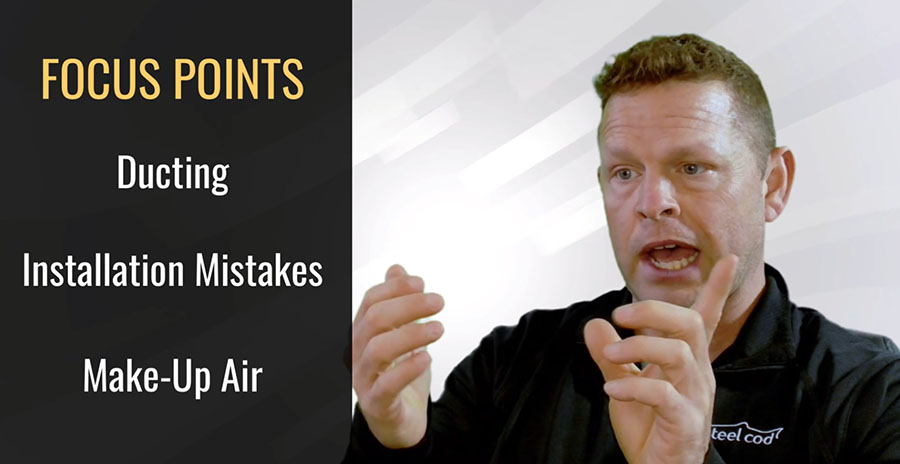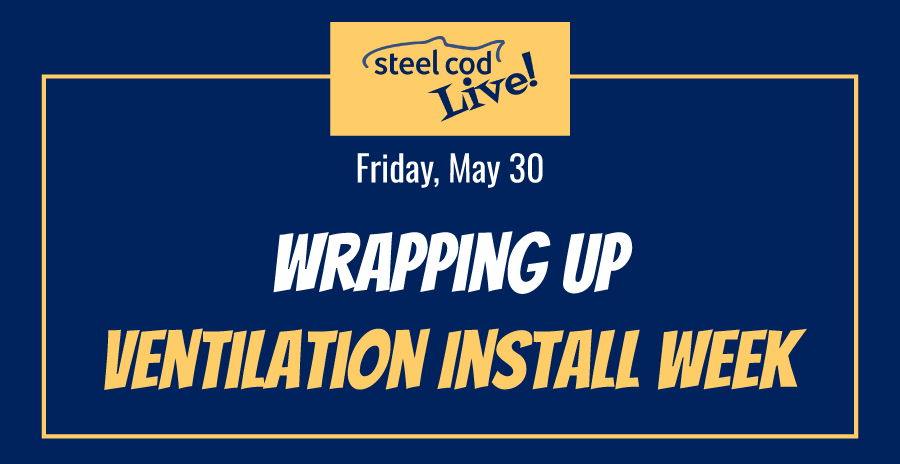The Best Hood Can Fail
Why Installation is Everything
The Best Hood Can Fail
A hood with bad ducting is like a sports car stuck in traffic—it won’t go anywhere. Even the most powerful ventilation system can fail if it’s not installed correctly. This week we’re covering the biggest mistakes that kill performance: restrictive ducting, incorrect mounting height, and ignored makeup air requirements. Learn how to spot and prevent these issues before they turn into customer complaints.
Top 4 Most Versatile Range Hoods for Installation
This week on Top X, we mention the most installer-friendly range hoods across premium, mid-tier, and budget categories. Whether you’re dealing with complex remodels, tricky ducting, or fast-moving projects, this episode highlights the hoods that deliver clean installs, flexible configurations, and zero headaches.
Wrapping Up Ventilation Install Week
This week on Steel Cod Live!, Tom returns to close the loop with Anthony and Jon on Ventilation Install Week — breaking down the biggest lessons, surprises, and questions from the field. They revisit what makes an install truly smooth, which hood designs consistently deliver, and what pros wish they knew before day one.
Recap
Key Questions and Answers
If I have a gas cooktop, do I need a stronger hood than someone with an electric range?
Yes. Gas produces more than just heat—it also creates moisture, carbon monoxide, and nitrogen dioxide. That means more contaminants to vent out. For gas ranges over 50,000 BTUs total, aim for at least 600 CFM, especially with high-heat cooking.
Is there a way to make a range hood quieter without reducing its performance?
Absolutely. Noise usually comes from airflow resistance, not the blower itself. Use larger ducting (8" if possible), minimize 90° turns, and consider an inline or external blower, which moves the motor outside the kitchen. Done right, performance stays high and sound levels drop drastically.
What are the most common installation issues that lead to product returns or complaints, and how can we prevent them?
Three main issues:
- Undersized ducting chokes airflow
- Incorrect mounting height reduces capture
- Improper venting (like into attics) is unsafe and ineffective
Prevention starts with asking simple questions about duct size, vent route, and hood placement before the sale.
Should we train sales teams to discuss installation up front, or is that better left to contractors?
Sales teams must bring it up. Most customers assume any hood will work—and contractors will install whatever is handed to them. Asking “Do you know your duct size and where your hood vents?” can prevent major post-sale issues.
How does cabinetry design affect range hood installation?
| Cabinet design element | Installation consideration |
|---|---|
| Mounting height | Too high and capture drops |
| Venting routes | May need modification to run ductwork |
| Hood width | If cabinet space is tight, choose a deeper model to maintain capture efficiency |
For kitchens without an exterior wall, what are the best alternatives for venting a range hood properly?
| Alternative option | Description |
|---|---|
| Rooftop venting | Up through ceiling |
| Soffit venting | Above cabinets, out through eaves |
| Inline blowers | Move airflow quietly over longer runs |
Recirculating hoods are a last resort—they trap odors but do not vent heat or grease.
How do I handle a customer who wants a powerful, high-CFM hood but doesn’t want to upgrade their ductwork?
Shift focus from raw CFM to usable performance. Undersized ducting creates noise, inefficiency, and backpressure. Offer:
- A hood with a larger capture area
- An inline blower to boost airflow
- Or a lower-CFM model that works better in their space
What’s the best way to explain the benefits of an inline or external blower to a customer?
Inline and external blowers move the motor out of the kitchen—usually into the attic or outside. That means:
- Less noise in the cooking area
- Stronger airflow over long duct runs
They’re ideal when the customer wants both high power and quiet performance.
How can we help customers understand the importance of installation without overwhelming them with technical details?
Stick to impact over engineering. Most customers don’t need to know airflow equations—they need to understand what happens if installation is ignored: more noise, weaker performance, and long-term frustration.
Use clear, relatable points—like how every sharp duct turn reduces airflow, or how undersized ducting can cause the hood to sound louder and pull less air. Focus on outcomes they’ll feel: cleaner air, less noise, and a setup that works right the first time.
What are the risks of installing a high-CFM hood without proper makeup air?
| Risk | Impact |
|---|---|
| Backdrafting | Pulls dangerous gases like carbon monoxide from fireplaces or water heaters |
| Pressure imbalance | Drafts, HVAC strain, poor airflow |
| Poor hood performance | Less suction, more noise |
| Code violations | Makeup air is required in many areas for hoods over 400 CFM |
Plan ahead with adjustable CFM settings or makeup air systems to avoid costly problems later.


